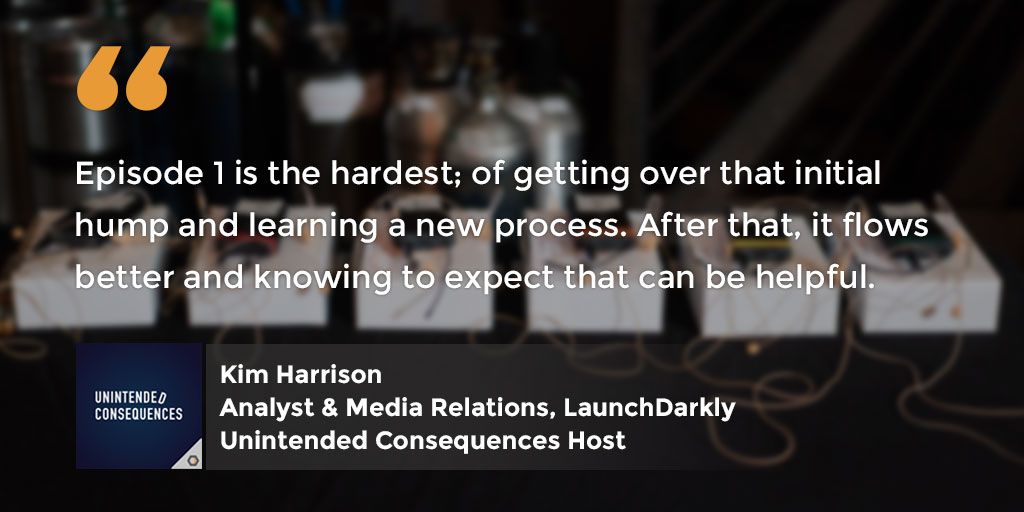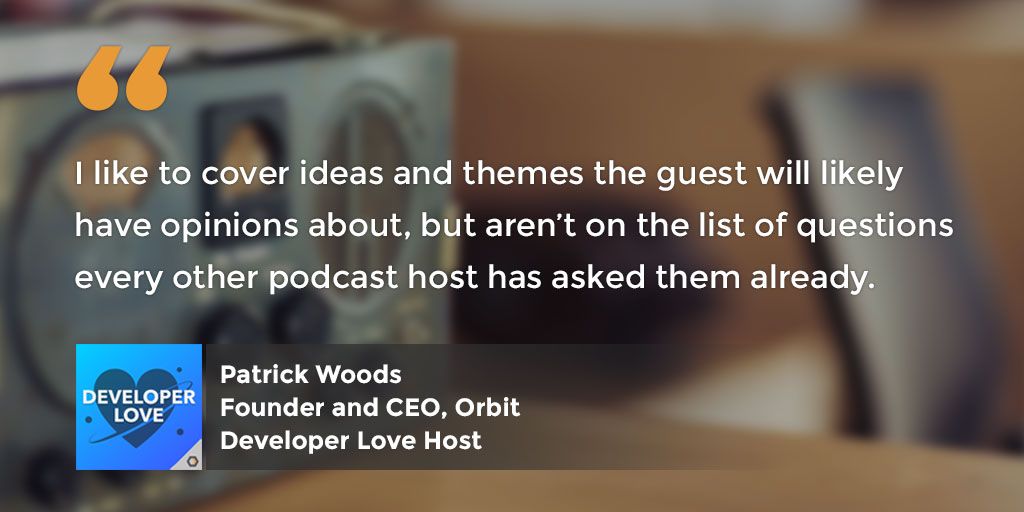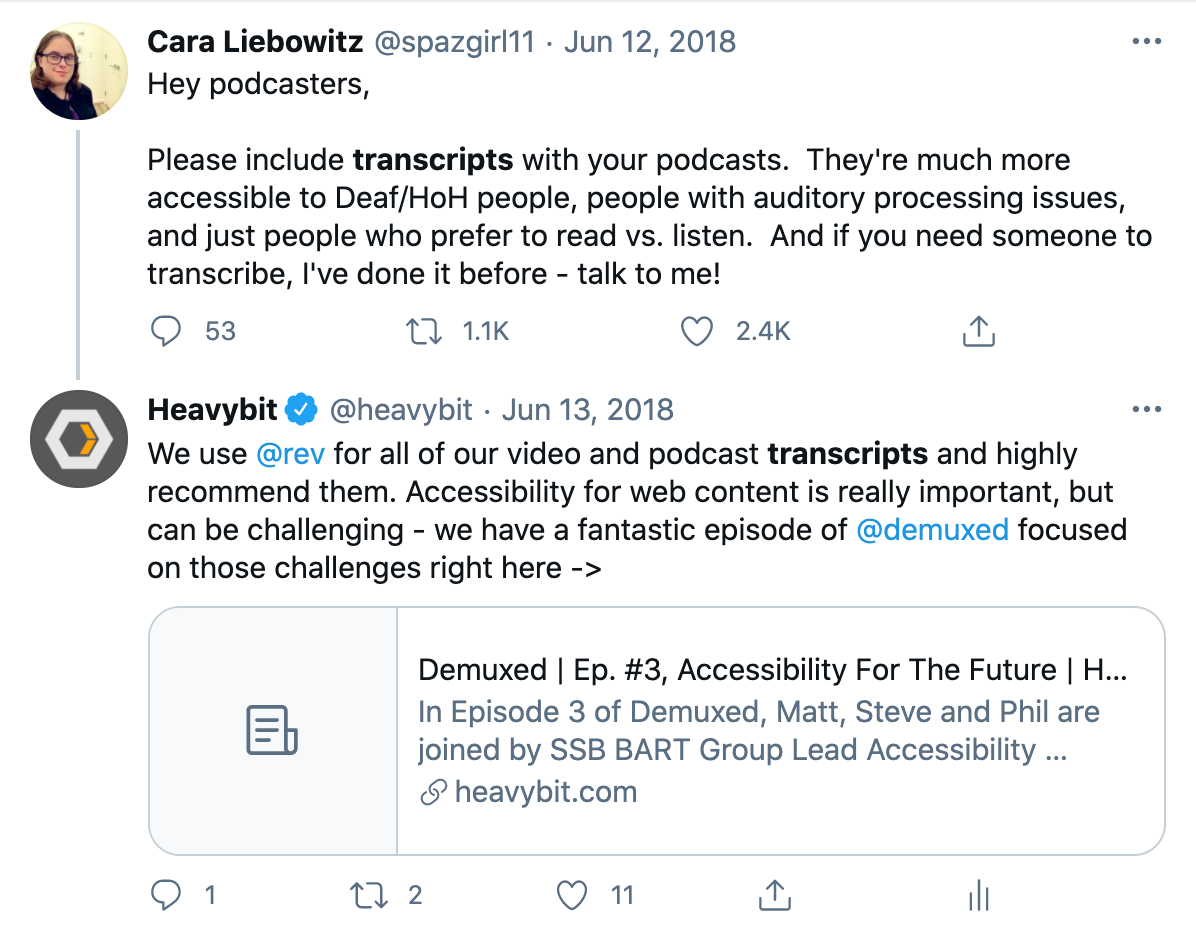So You Want to Start A Show: Podcasting Best Practices
 Ted CarstensenPlatform Director
Ted CarstensenPlatform Director
Heavybit Lucas Oswald
Lucas Oswald Kim Harrison
Kim Harrison Patrick WoodsCo-Founder & CEO
Patrick WoodsCo-Founder & CEO
Orbit
Editor’s Note: Over the last couple of years, podcasting has become a booming industry, and 2020’s shift from in-person activities to digital events and community has only accelerated that growth. It’s also proven to be an efficient way to do more with less (unsure of what I’m referring to? Check out this post.)
Since 2015, Heavybit has launched 18 shows with a combined 350+ episodes, and some of those shows have served as the foundations for global, standalone communities. If you’re considering starting a show (or already have a show) and are looking for tips on ensuring ROI, read on to learn more about our best practices.
Thanks to Heavybit team members Ted Carstensen, Lucas Oswald, and Ashley Dotterweich for their help with this guide.
Preparing for Launch
Objectives and Strategic Planning
The first, and most important step to making your show succeed is understanding why you’re doing it. Though advancements in tooling have made it easier to produce shows, it’s still a meaningful time and energy commitment. If it’s not worthwhile for you, it won’t be for your audience either. No amount of editing is going to be able to keep listeners from picking up on a lack of intention and effort.
Start a doc with the answers to the below questions and make sure everyone involved with producing the show is aligned on these decisions. And don’t forget to make the doc easily accessible so that anyone can step in at any moment to keep the show running.
Goals: What do you want to accomplish with the podcast? What does success look like for this show 6 months from now?
Logistics: How frequently do you want to release episodes? Who will host the show? Who will own the different steps of the process (booking, promoting, etc.)?
Content: Who is your target audience? What topics would you like to cover? What are the criteria for a guest?
We recommend having 1-2 hosts, any more and your guests will have a hard time getting a word in. Having 2 hosts relieves some of the pressure of hosting and gives you an opportunity to share each episode to a larger audience.
Assets
Every show needs a name, a description, and artwork. You’ll not only be asked for these things when you submit your feed to various podcast directories but preparing these things is a good forcing function for thinking through the whats, whys, and hows of your show. The music and artwork you choose will set the overall tone and vibe. The description will be part of the intro/outro script and can be the abstract you use to invite guests.
When it comes to naming your show, make sure there aren’t any existing shows with similar names. Assuming the episodes will be hosted, or at least promoted, on your site, this is also an exercise in content marketing and SEO strategy. Do a keyword analysis to figure out what terms will perform the best.
Sourcing Guests
Where you source your guests will depend on what the objectives of your show are. Is it to meet customers? Is it to educate your users? If you have a pool of people interested in speaking at your events or contributing posts to your blog, asking them to be guests on your show is a lower-stakes, lower-calorie way of getting them involved. Or get stakeholders who have a vested interest in seeing you succeed involved. Another great way to source guests is to ask your audience or end every episode with a question for your guest, “who would you recommend we talk to next?”
The planning and publishing portion of every episode takes a lot longer than the actual recording portion so try to get as much of a head start as you can to keep a regular cadence. Build a list of potential guests, think about who in your network can connect you to them, and start assigning owners.

Recording Your First Episode
Recording Gear
Luckily, podcasting has become less expensive with the shift to remote work and acceleration of digital tooling. For high-end shows, studios needed to be rented and guests needed to travel but now, the minimum viable setup is really just a recording app, a quiet space, and a decent mic, which most everyone should have by now.
Microphones and Headphones
Pretty much anything will be better than your laptop’s built-in mic. USB ones like Blue Yeti and Blue Snowball are popular among podcasters for their ease of use and affordability. If wired Apple EarPods are your only choice, be careful about the placement of the mic throughout your recording session. Avoid dragging and bumping the inline microphone as much as possible as it’ll affect the quality of your audio.
Headphones are a must. If possible, use over-ear monitors like these, or earbuds, to prevent the sound from leaking into your microphone. For more in-depth recommendations on podcasting gear, check out these guides from Dan Benjamin and Joel Hooks.
Recording Apps
We recommend using Zencastr for recording remote podcast audio. The app records each speaker on their own computer and splits each speaker into a separate track to ensure high-quality sound capture – no more strange artifacts and hiccups from unstable internet connections. Check out Zencastr’s docs on recording your first episode with Zencastr and a guide to share with your guests.
The inability to see your guest and pick up on cues can be seen as a challenge of remote podcasting and we’ve seen tools like SquadCast gain in popularity. But we’ve also heard from folks that (digital, not necessarily in-person) visuals can be distracting and add a layer of self-consciousness. Our advice here is to check-in with your guests. Everyone has differing levels of confidence, comfort, and experience with these new tools and your job as host is to make sure the conversation flows smoothly, so just ask for their preferences. If you do choose to add video, we caution against simply recording a video call because it adds additional steps to the editing process and audio may be low quality.
Where to Record
Minimize background noise and echo. Avoid recording in larger, reflective rooms with harder surfaces like glass, tile, rock and metal. Try to find a smaller room where surfaces are largely made of softer materials (wood, sheetrock, carpet, rugs, furniture, etc.) like a small home office or carpeted bedroom.
Before you begin recording, take a quick look around the room and see what simple measures you can take to avoid capturing unwanted sounds. A device with audible notifications, a squeaky chair, a yipping pet, an audible AC –any precaution that can be taken to avoid these kinds of things will improve the quality of the recording.
Being an Effective Host
Conducting in-person interviews requires a lot of energy and confidence. Interviewing remotely can be harder because of latency issues and dropped connections. The one thing all great in-person and remote interviewers have in common is a lot of practice.
Some good hygiene to practice as a host:
- Never interrupt your guests. Silence is okay, don’t scramble to fill it. Let your guests’ answers land for a beat before asking another question.
- Avoid cross-talk. Without a visual aid, the audience just interprets two or more people speaking simultaneously as noise.
- Speak confidently and avoid overusing placeholder words like “ummmm,” “ya know,” “like,” and “kind of,” whenever possible.
- If a question you’re asking takes on a new life as you’re developing your thoughts, consider starting over and giving a clean and clear delivery of the intended question.
- If you ever get tongue-tied, stop, take a breath, and restart. Pauses can always be edited out.
As mentioned above, you should be treating your podcasts as a piece of content so we won’t be going into depth about howtoproduce content of high quality, as we already have plenty of helpful guides in the Library. Remember, high-quality content is educational, entertaining, and engaging.

Editing and Publishing An Episode
Avoid Having to Edit
At Heavybit, all of our podcasts are edited meticulously in post-production, thanks to our Podcast Network Manager Lucas Oswald. But we understand that having a dedicated audio editor isn’t always an option for time or budget reasons. That’s not to say you can’t produce high-quality episodes on a budget.
In addition to the recording tips above, the better prepared your hosts and guests are, the better your episode will turn out. The more composed everyone is, the easier it is to find and cut the awkward parts. The more experienced the host, the better they’ll be at rephrasing confusing points.
Tools

There are lots of tools out there to help with post-production. We use Frame for folks to be able to leave feedback with timestamps for edits. Unintended Consequences host Yoz Grahame also recommends Descript, which works as a collaboration, recording, and transcription tool in one.
The feedback we get most often from listeners is, “Thanks for providing time-coded transcripts.” Transcribing is time and resource intensive but the payoffs are high; transcripts provide accessibility to folks with hearing disabilities, cater to folks who prefer to read, and make your show discoverable to search engines. We recommend using a service like Rev for reliable and fast transcripts. At the very least, include a time-stamped outline with every episode.
Promoting Your Show
Social Channels
If you’ve done your homework of determining who your target audience is during the objective-planning stage, then you should already know the channels they’re likely to be hanging out in. But lately, people are so hungry for podcasts, submitting your feed (with the correct categories) to as many podcast directories as possible is a great way to increase listenership.
Some of our most popular shows have dedicated account handles but again, whether you should do that will depend on what your objectives are. If the podcast is supposed to generate leads for sales, you should be promoting it through the corporate account. If the goal is to build a revenue-agnostic sub-community for users, create a separate space to build that up.
Repackaging Your Episodes
Podcasts are fun in that they can be repackaged in a multitude of mediums. For every episode, we create a set of quote images and audiograms using Headliner. Tweets with images receive 150% more retweets than tweets without images and short videos generate 1200% more shares than text and image content combined.
You should be promoting every episode but don’t miss opportunities to promote the show itself. Individual stream and download counts are important but what’s more important is encouraging people, who stumbled upon your one viral episode, to check out the rest and ultimately, subscribe to your show. Whenever you have a couple of new episodes go out, repackage them into a campaign to drive people to subscribe, rate, and leave reviews, which should increase your reach into untapped audiences.
Lean on Your Guests
Lastly, thank your guests. People come onto your show because they get a chance to share their stories and thoughts with a larger audience so tag them on social media and make it easier for them to share with their networks by pre-drafting tweets.
Episodes don’t need to be released in the order that they were recorded in. If your guest and/or their company has an exciting launch coming up, take advantage of that and publish the episode to coincide with it.
We’ll be updating this guide regularly with additional tips so check back often, and let us know if you’d like to add anything or if we’ve missed something. Good luck!
You can hear these tips in practice by streaming and subscribing to the shows in the Heavybit network. Follow us on Twitter to stay updated on the newest episodes.
Subscribe to Heavybit Updates
You don’t have to build on your own. We help you stay ahead with the hottest resources, latest product updates, and top job opportunities from the community. Don’t miss out—subscribe now.
Content from the Library
Recommended Listening: Our Favorite Podcasts from 2020
Editor’s Note: Over the last couple of years, podcasting has become a booming industry, and 2020’s shift from in-person...
The Kubelist Podcast Ep. #12, Istio with Craig Box of Google Cloud
In episode 12 of The Kubelist Podcast, Marc speaks with Craig Box of Google Cloud. They discuss Istio’s features and community,...
Jamstack Radio Ep. #74, Redefining JAMstack with Debbie O’Brien of NuxtJS
In episode 74 of JAMstack Radio, Brian speaks with Debbie O’Brien of NuxtJS. They discuss the use cases of NuxtJS, tactics for...